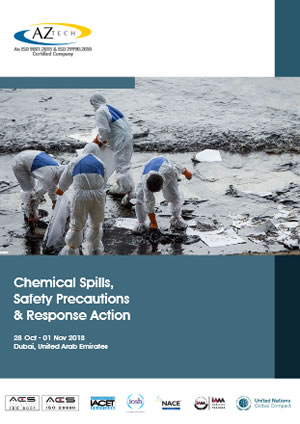This week, delegates from companies spanning Kuwait to Saudi Arabia gathered at the Fairmont Dubai to sharpen their skills in preventing chemical spills and effectively responding to mitigate any potential impacts. Dave Annells, an experienced process engineer, chemical industry consultant, and international trainer, is leading this course with exceptional success.
Key Takeaways from the Course
Understanding Chemical Hazards
“All chemicals are hazards” – or could become hazards if mixed with incompatible chemicals, especially in poorly managed warehouses or storage systems. This fundamental lesson highlights the importance of proper chemical handling and storage.
Small Acts, Big Disasters
“Big disasters could stem from small acts” – historically, significant emissions have resulted from seemingly trivial acts, omissions, or misunderstandings. This underscores the critical need for meticulous attention to detail in chemical management.
Explore Training Courses:
The Danger of Water
“Water can kill” – water can become a contaminant, potentially causing chain reactions, explosions, and fatalities. This point drives home the complexities involved in managing chemical interactions and preventing unwanted reactions.
Promoting a Safety Culture
The course emphasizes that the best way to avoid chemical spills is to prevent them from occurring in the first place. Key elements include:
- Spreading Safety Culture: Educating workers about how to handle chemicals and respect their hazards reduces risks. Equipping responders with the knowledge to act safely and effectively according to rehearsed plans leads to cost-effective operations. Good safety is good business, while poor safety can have severe financial repercussions.
- Beyond PPE: It’s not just about providing personal protective equipment and tools to manage spills. It’s about equipping operators, technicians, engineers, supervisors, and managers with a deep understanding of what they are handling within a culture that promotes safety. Ultimately, all chemical release incidents come down to human error. The focus is on educating people, influencing their behavior, facilitating communication, and protecting individuals and communities.
Learning from the Past to Improve the Future
Using a mix of training techniques and numerous case studies, delegates are gaining valuable insights into the errors and cultural factors that have historically led to chemical releases. They learn from past mistakes and discuss successful designs and approaches to avoid repeating them. By committing to adopting these learnings, participants are poised to make a positive impact on the present and future safety landscape.
Reducing Chemical Release Incidents
The Chemical Spills, Safety Precautions & Response Actions course aims to significantly reduce the number of future chemical release incidents. It also seeks to improve emergency response plans for those incidents that may still occur. By the end of the course, delegates will be better prepared to handle chemical safety in their respective organizations, contributing to a safer and more efficient industry overall.
